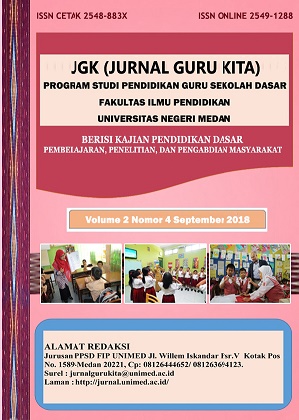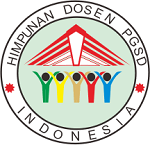PENGARUH MODEL PEMBELAJARAN KOOPERATIF TIPE THINK PAIR SHARE TERHADAP KEMAMPUAN PEMECAHAN MASALAH MATEMATIKA KELAS V SD NEGERI PRAPAG KIDUL 03
DOI:
https://doi.org/10.24114/jgk.v2i4.13574Abstract
Abstract: The Influence of Cooperative Learning Model Type Think Pair Share on Mathematical Problem Solving Ability of Class V in Prapag Kidul Elementary School 03. This study aims to determine the effect of think pair share learning model on problem solving ability in class V of pre-school kidul level 03 elementary school. This research was conducted in class V Prapag Kidul Elementary School 03 in May 2018. The subjects of this study were VA and VB. The research method used in this study is a quantitative research method using Quasi Experimental Design research design using the Nonequivalent Control Group Design form. Data collection methods used in this study are documentation and tests. The results of the learning completeness test showed that the problem-solving ability of fifth grade students of Prapag Kidul Elementary School 03 using think pair share learning model reached KKM 65. The average value in class 81.15 and minimum completeness criteria (KKM) 65, obtained tcount = 6.83982 with n = 20 and t table = 2.09302. So the results of the calculation are known to be t count> t table. It can be concluded that the ability to solve mathematical problems in the experimental class is better than the control class.Keyword: Cooperative Learning, Think Pair Share, Problem solving skillAbstrak: Pengaruh Model Pembelajaran Kooperatif Tipe Think Pair Share Terhadap Kemampuan Pemecahan Masalah Matematika Kelas V SD Negeri Prapag Kidul 03. Penelitian ini bertujuan untuk mengetahui pengaruh model pembelajaran think pair share terhadap kemampuan pemecahan masalah kelas V SD Negeri prapag kidul 03. Penelitian ini dilaksanakan di kelas V SD Negeri Prapag Kidul 03 pada bulan Mei 2018. Subjek penelitian ini adalah siswa kelas V A dan V B. Metode penelitian yang digunakan dalam penelitian ini adalah metode penelitian kuantitatif menggunakan desain penelitian Quasi Eksperimental Design dengan menggunakan bentuk Nonequivalent Control Group Design. Metode pengumpulan data yang digunakan dalam penelitian ini adalah dokumentasi dan tes. Pada hasil uji ketuntasan belajar menunjukkan bahwa kemampuan pemecahan masalah siswa kelas V SD Negeri Prapag Kidul 03 yang menggunakan model pembelajaran think pair share mencapai KKM 65. Nilai rata-rata pada kelas 81,15 dan kriteria ketuntasan minimum (KKM) 65, diperoleh thitung = 6,83982 dengan n = 20 dan ttabel = 2,09302. Sehingga hasil pehitungan diketahui thitung> ttabel. Dapat di simpulkan bahwa kemampuan pemecahan masalah matematika pada kelas eksperimen lebih baik dari kelas kontrol.Kata Kunci: Cooperative Learning, Think Pair Share, Kemampuan Pemecahan MasalahDownloads
Published
2019-08-05
How to Cite
Hanifah, F. (2019). PENGARUH MODEL PEMBELAJARAN KOOPERATIF TIPE THINK PAIR SHARE TERHADAP KEMAMPUAN PEMECAHAN MASALAH MATEMATIKA KELAS V SD NEGERI PRAPAG KIDUL 03. JGK (Jurnal Guru Kita), 2(4), 39–48. https://doi.org/10.24114/jgk.v2i4.13574
Issue
Section
Articles
License
Authors published with the JGK (Jurnal Guru Kita) agree to the following terms:
- Authors retain copyright and grant the journal the right of first publication with the work simultaneously licensed under a Creative Commons Attribution License (CC BY-SA 4.0) that allows others to share the work with an acknowledgment of the work's authorship and initial publication in this journal.
- Authors are able to enter into separate, additional contractual arrangements for the non-exclusive distribution of the journal's published version of the work (e.g., post it to an institutional repository or publish it in a book), with an acknowledgment of its initial publication in this journal.
- Authors are permitted and encouraged to post their work online (e.g., in institutional repositories or on their website) prior to and during the submission process, as it can lead to productive exchanges, as well as earlier and greater citation of published work. (See The Effect of Open Access)




























